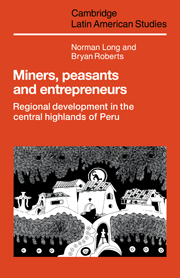Book contents
- Frontmatter
- Contents
- List of tables
- List of figures
- List of maps
- Preface
- 1 Regional development in an export economy
- 2 The development of a regional economy in the central highlands
- 3 The Mining Corporation and regional development
- 4 Class relations, local economies and large-scale mining
- 5 Highland puna communities and the impact of the mining economy
- 6 Migration and social differentiation amongst Mantaro valley peasants
- 7 Industrialization and the emergence of an informal regional economy
- 8 The village economy, agricultural development and contemporary patterns of social differentiation
- 9 Regional commitment among central highlands migrants in Lima
- 10 Confederations of households: extended domestic enterprises in city and country
- 11 Regional development in peripheral economies
- Notes
- Bibliography
- Index
- Titles in the series
8 - The village economy, agricultural development and contemporary patterns of social differentiation
Published online by Cambridge University Press: 07 May 2010
- Frontmatter
- Contents
- List of tables
- List of figures
- List of maps
- Preface
- 1 Regional development in an export economy
- 2 The development of a regional economy in the central highlands
- 3 The Mining Corporation and regional development
- 4 Class relations, local economies and large-scale mining
- 5 Highland puna communities and the impact of the mining economy
- 6 Migration and social differentiation amongst Mantaro valley peasants
- 7 Industrialization and the emergence of an informal regional economy
- 8 The village economy, agricultural development and contemporary patterns of social differentiation
- 9 Regional commitment among central highlands migrants in Lima
- 10 Confederations of households: extended domestic enterprises in city and country
- 11 Regional development in peripheral economies
- Notes
- Bibliography
- Index
- Titles in the series
Summary
Decline in the economic significance of the mining sector has not been compensated by the development of agriculture. Despite increasing urban concentration, the rural population has continued to grow, increasing pressure on existing land resources. Using the census definition of'rural’ locations (less than 5,000), there has been an increase in the rural population of Junin in the intercensal years from 1961 to 1972 from 265,458 to 281,890. And by 1980, it was estimated that this rural population had increased to 349,176. (Indicadores estadtsticos, 1981: Tables 27, 28). Urban growth was more rapid, but many of these ‘urban’ places were large villages in which a majority of the population still farmed as their major economic activity. The average landholding in 1972 was 2.4 hectares, but this figure concealed significant inequalities in the distribution of land with 38 per cent of farms in the Mantaro valley zone possessing less than half a hectare (Long and Roberts, 1978: 11). The agrarian reform office estimated that the amount of land needed for basic household subsistence was three hectares; yet about half the households in Junin had less than this minimum holding (Huancayo Plan Director, 1976: 36).
Increased demographic pressure was not accompanied by an increase in agricultural production. Agricultural statistics show no evidence of significant improvements between the 1950s and the 1970s, either in levels of production or in productivity of the four main food crops: potatoes, maize, wheat and barley. In the highlands of Junin, the total amount of cultivated land had probably reached its limits by the 1970s and the major new sources of cultivated land were located in the tropical lowlands.
- Type
- Chapter
- Information
- Miners, Peasants and EntrepreneursRegional Development in the Central Highlands of Peru, pp. 169 - 197Publisher: Cambridge University PressPrint publication year: 1984



